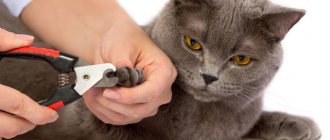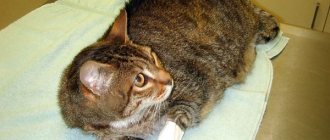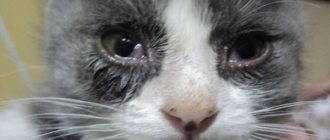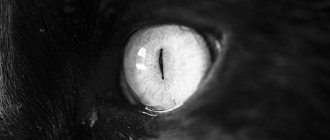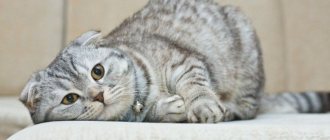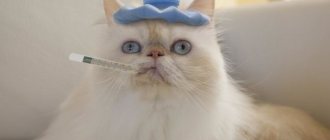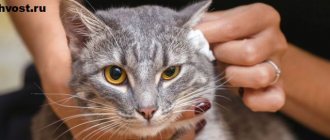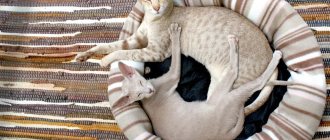Each of your cat's ears is controlled by a complex system of thirty-two muscles. Just imagine!
Thirty-two power cords, each of which can contract and relax with different tension. Incredible! For comparison, humans have only six muscles that control ear movement.
This entire amazingly complex system allows the cat to control its ears autonomously. that is, if necessary, direct them in different directions. In addition, a cat turns its ear in the direction of an unexpected sound signal ten times faster than a dog, and is also able to accurately judge its volume, speed and location from where it comes. To do this, the cat's ears can rotate 180 degrees, press against the head, and change their shape.
A cat’s ability to hear and distinguish sounds is very high, which is not surprising - with such “acoustic equipment”! But what is especially interesting for owners is that by the position of a cat’s ears one can judge its emotions and it is quite easy to figure out what it is feeling at the moment. So let's observe and remember.
Ear cleaning procedure
Before starting the procedure, prepare everything you need.
The upper part of the ear is cleaned with a cotton sponge or neutral wet wipes.
For the lower one, it is advisable to use children's cotton swabs with limiters - this way there is less risk of injuring the animal. You need from 2 to 4 of them for each ear, depending on the degree of contamination. You should not use the same stick for different ears, even if it seemed to remain clean.
Prepare enough blades and chopsticks so that you don't have to take a break because you don't have enough.
Do not use homemade matchsticks - the cotton wool can easily slip off and remain in the ear. In addition, in this case there is a high risk of scratching the animal.
If possible, prepare a small flashlight - it will allow you to better examine the auricle. If necessary, warm the cleanser to room temperature.
It is best to carry out cleaning when the cat comes on its own and asks for attention or is half asleep. During the procedure, talk quietly and gently to your pet to calm him down.
How to clean a cat's ears:
Place your pet on a table or in your arms
If he is calm about the procedure, you can simply hold him with your hand; if he breaks out, carefully swaddle him in a towel or call an assistant. Gently turn the ear outward - this is not painful and will not harm the animal. With fold-eared cats, as well as those with curled ears, for example, curls and lefties, you need to act especially carefully.
Carefully examine the ears for symptoms of disease. Place 5-7 drops of lotion or saline solution into your ear - the exact dose should be indicated by the manufacturer. For kittens, 2-3 drops are enough. Gently massage the base of your ear for a minute. Allow the cat to shake its head and shake the liquid and loosened dirt out of the ears. For light contamination this is sufficient. If it is very dirty, wipe the upper part of the ear with a sponge, and clean the lower part with a cotton swab. It can be immersed to a depth of up to a centimeter, for kittens - half a centimeter. Don't be afraid to puncture your eardrum - this is impossible due to the curves of the auricle, although you still need to act carefully. Move the wand outward rather than inward to remove dirt rather than push it deeper. After cleaning is complete, praise and pet the animal and reward it with a treat.
Accustoming kittens to the procedure
It is very important to teach your pet to calmly endure the ear cleaning procedure, otherwise in the future, by struggling and resisting, he will complicate the owner’s task, and besides, by jerking at the wrong moment, he can seriously harm himself. It is advisable to play with the baby in advance so that he gets tired and calms down.
It’s not worth interrupting the game in the midst of it - the kitten will be too excited and will probably resist, and the procedure in this case will cause unpleasant associations for him
It is advisable to play with the baby in advance so that he gets tired and calms down. It’s not worth interrupting the game in the midst of it - the kitten will be too excited and will probably resist, and the procedure in this case will cause unpleasant associations for it.
An animal accustomed to the procedure from childhood most often perceives it calmly.
Stroke the prepared animal, talk softly and affectionately to it to calm it down
If the kitten still resists touching its ears, you can restrain it by gently wrapping it in a towel.
Please note that you cannot express your dissatisfaction with the animal or scold it, much less act rudely. Even when swaddling a kitten, speak friendly
Praise him in moments of calm and obedience.
After completing the cleaning, be sure to give the kitten a treat and, if he wants, play with him - the procedure should be associated with pleasure.
The attitude towards ear cleaning largely depends on the character of the animal. Our first cat never struggled or showed aggression during the procedure; he only pressed his ears to his head with force, so it took some effort to straighten them. Since at the same time he usually sat quietly next to her, without trying to escape, it seemed that he saw this as a kind of game.
If your pet reacts aggressively to the procedure, trim the nails in advance or attach anti-scratch guards to them.
Cat breeds with ear tufts
There are cat breeds in which ear tufts are one of the indicators of their breed. Prominent owners of such an accessory on the tips of the ears are the following breeds.
Maine Coon
The origin of the breed of these cats is covered in some legends and speculations that have nothing to do with reality. Previously, there was a legend that a Maine Coon cat was the ancestor of a crossed raccoon and a cat, due to the large and powerful tail of the giants. Another theory of origin is that the Maine Coon was the result of crossing a domestic cat and a wild lynx. And all because of the unusual color and the presence of tassels on the ears.
Scientists claim that the breed was created as a result of the natural process of evolution. Beautiful and friendly giants, open to communication, quickly get used to the owner and miss him, like dogs. Despite their impressive size, these cats are very loving and rarely use their sharp and rather large claws. Adult representatives of this breed are distinguished by their phlegmatic nature, sitting imposingly on an elevated platform and viewing the actions that are taking place below.
Pixiebob
The name of the breed is no less funny than the translation from English. This breed was artificially bred, and the name is translated as short-tailed elf. Pixiebobs were bred in the United States as a result of crossing a cat that had a short tail and suffered from polydactyly, as well as a female that was beautifully colored and had no tail at all. The result of this crossing was a kitten that looked like a lynx, with a stub instead of a normal tail. As in the case of the Maine Coon, legends are formed around the origin of the Pixiebob breed that have nothing to do with reality. Some argue that these cats were created by crossing wild bobtails and a domestic cat, while others believe that pixies were obtained by crossing a domestic cat with a red American lynx.
If you look closely at the parameters of this breed, it becomes clear where these speculations came from, because male pixie bobs reach a weight of more than 10 kg. These cats grow slowly, reaching the size of an adult animal only by the age of 4 years. The head of this breed is shaped like an inverted pear, and the eyes are triangular, framed by overhanging eyebrows, which gives it a rather gloomy appearance. And of course, tassels on the tips of the ears.
Pixiebob cats are loyal and flexible, but they choose and recognize only one owner. In terms of affection, like Maine Coons, these cats are compared to dogs. They can actively play outdoor games and even bring toys.
Norwegian forest
The birthplace of Norwegian cats is Norway. These are one of the oldest cat breeds. As with other cats with their impressive size and tufted ears, these cats are believed to be related to lynxes.
Distinctive features of this breed are a thick coat with an undercoat to protect against winter cold and the water-repellent properties of the coat. The most common colors of Norwegian forest cats are black, white, red and gray. Adult cats reach a weight of 8 kg. The head of these cats is triangular, framed by widely spaced ears with tassels. True, in Norwegian forest cats the tassels are rather weakly expressed.
These cats are considered true long-livers among domestic cats, as they live up to 20 years or more. Born hunters, they love active games, the purpose of which is to “attack” and “capture the victim.” At the same time, Norwegian cats have a gentle character, are very friendly and patient. They love affection, but do not particularly sit on the lap, even of their owner.
Caracal breed
The caracal is not exactly a domestic cat. These are wild hunters who, over the course of many years, have become accustomed to living alongside humans. The homeland of caracals is wild Africa, but a kitten taken from nature cannot be domesticated. Only those born in captivity can be considered domesticated.
These cats have huge tassels on their ears, which stick out in different directions like the bristles of a brush in young cats, and in older cats, they begin to gradually fall down. The coat of these beauties is hard, dark brown in color, and only black in small areas. This is mainly the area around the eyes, mouth and nose, as well as the outer part of the ears with tassels. The cost of this cat breed is decent, so not many people can afford it. On average, the price for a caracal kitten is from 10 thousand dollars.
This breed of cat is kept free in a spacious enclosure. This breed of cat also needs to be fed especially, because ordinary industrial food is not suitable for them. Those who own caracals talk about the peaceful nature of these animals, sociability and affection for the owner.
Siberians
The Siberian cat breed is very similar to the Norwegian forest cat. These animals are hardened in harsh climates. In addition to thick fur with down, “Siberians” have tufts on their ears and tufts of hair located in the interdigital space.
There is an assumption that forest cats became the ancestors of this breed. There is also a theory that Siberians came to the European part of Russia from Asia along with nomadic tribes. It is noteworthy that modern Angora and Persian cats have many common roots with Siberian cats.
These cats are stocky, have powerful muscles and endurance. Male Siberian cats are large, reaching large sizes and weighing 12 kg. Females are significantly smaller in size, weighing no more than 6 kg. Like Maine Coon and Pixie Bob cats, Siberians reach the size of an adult cat only by 4-5 years of age.
It is believed that the Siberian cat, despite its fluffiness, is a hypoallergenic breed. The fact is that the body’s specific reaction to cats occurs not to fur, but to protein contained in saliva, urine or skin. So, in these cats, the amount of allergenic substances in the salivary secretion is very small. Siberian cats are excellent hunters, easily coping not only with small rodents, but also with larger prey. They are attached to their owner, love affection, but do not tolerate disrespectful treatment. They recognize only one breadwinner, can be offended and do not like to sit in their arms for a long time. These cats prefer to watch what is happening in remote solitude, climbing higher. It is worth understanding that the weight of these cats is not small, so not every shelf will withstand such a load.
Inspection and Cleaning
In order to assess the condition of the ears, you first need to bend the auricle. Some owners are afraid to do this, believing that it causes pain in the animal. This is actually a myth. The cat will not feel any pain
Pay attention to the condition of the inner wall of the ear. It must be clean, without the slightest trace of any contamination.
If you notice any defects, they may indicate the presence or development of a disease. Such troubles include:
- lumps of dirt;
- scratching on the surface of the ear;
- dark spots;
- tubercles;
- dark colored discharge.
For inspections, it is recommended to buy a small flashlight. It will help you look inside the ear and verify the presence or absence of dirt. If there is a need for cleaning, it must be done. Experts recommend accustoming the animal to such procedures from a very early age. Cats don't like cleaning, so they try to escape, leaving noticeable claw scratches on their owners' hands. Therefore, professionals advise buying anti-scratch guards and putting them on your claws.
To clean, you will need cotton swabs, ear gel and a towel to wrap your cat in. The procedure is done as follows:
- You need to turn the cat's ear out as far as possible to gain full access.
- A cotton swab is lightly immersed in the gel, after which the auricle is wiped. Pouring gel into the ear is strictly prohibited.
- The stick plunges into the ear about 1 cm. Don’t be afraid to insert it so deeply, you won’t cause any harm to the cat.
- Cleaning is done using an inside-out motion to remove dirt from the ear.
How to clean
When cleaning your cat's ears, create maximum comfort
The cleaning procedure itself is simple. But you have to take your preparation seriously.
It is important to choose the right tools and tune the animal. This is a stressful situation for a pet, and if some nuances are not taken into account, an inexperienced owner will not be able to avoid scratches from sharp claws
Psychological comfort of cats during ear cleaning
Cats have an excellent memory, and if the procedure of cleaning the ears of an animal is unpleasant, these memories will force your pet to avoid it and resist in every possible way in the process.
Therefore, it is important to learn how to apply elements of training so that hygienic measures are associated with pleasant things. This way you will provide your cat with psychological comfort while cleaning its ears.
- Do not grab the animal suddenly, this will scare it. Chat with him before this, play a little.
- Examination of the ears should be carried out in a position that is comfortable for the cat.
- When an animal behaves irritably, scratching its chin and withers will help calm it down.
- Sudden movements and screams will scare away the pet. All actions must be performed calmly.
- To prevent the cat from scratching during the cleaning process, you can wrap it in a blanket or towel. There is no need to swaddle tightly, much less tie the paws with a rope.
Prepare the necessary items and examine the cat’s ears
When cleaning, carefully inspect your cat's ears.
During the cleaning procedure, it is better not to be distracted by searching for the right product or clean tampons. The cat can use this time to hide in a secluded place and avoid an unpleasant activity. Prepare everything in advance. You will need:
- a diaper, blanket or towel to hide paws with sharp claws under;
- a bright flashlight – it makes it easier to inspect ears;
- cotton swabs, disks;
- hygiene product (ointment, gel) for cleaning ears;
- a treat given to an animal as a reward after cleaning.
Using a flashlight eliminates the need to turn the cat to make a good inspection. Try to keep bright light out of the cat's eyes.
During the examination, pay attention to whether any changes have occurred inside the auricle, which may signal illness or the appearance of parasites
How to properly clean a cat's ears
Use swabs or cosmetic discs to clean your cat's ears.
Experts recommend using soft cotton swabs and cosmetic discs to clean your ears. You should not use cotton swabs or turunda on a match - they can scratch the skin. As a last resort, you can wrap your finger in a soft cloth and wipe your ears with it.
Veterinary pharmacies have a large selection of hygiene products for softening animal earwax. They are available in the form of a gel or ointment. Heated baby or vegetable oil is also suitable for these purposes.
What not to do
It is strictly forbidden to use some hygiene products to clean the delicate skin of a cat's ears. These include:
- soap solutions;
- hydrogen peroxide;
- vinegar;
- alcohol-containing substances.
Such products dry out the skin, which leads to the appearance of cracks and wounds. In addition, they promote increased sulfur secretion.
How to properly clean a cat's ears at home
To clean a kitten's ears from dirt, as a rule, it is enough to wipe the inside with a cotton pad. Earwax is not yet released in large quantities. The hygiene procedure is performed in the following order:
The kitten's back is held with one hand and lightly pressed, forcing it to lie down. They talk kindly and praise you for your perseverance. Carefully turn out the ear. Clean the surface with a disc. Praise the pet again and give a treat.
If your cat is accustomed to such manipulations as teeth brushing or veterinary examinations, cleaning the ears at home is not difficult.
- The pet is placed on its stomach or side.
- Using your fingers, turn the ear a little and pull it outward.
- Use a cotton swab or swab to wipe the inner surface from the inside out.
To wash your cat's ears, you can use warm, sleepy tea or chamomile decoction. The internal cavity is greasy to the touch - do not wipe the skin with soapy water.
If the animal is aggressive, you can try swaddling the cat in a blanket or towel for the procedure. It is worth understanding that with this approach, the owner is guaranteed heart-rending screams and howls, as a sign of gratitude from the scratching and biting animal. First try the method below:
- Put a thick mitten on the left hand (if the owner is right-handed) (a kitchen mitt will do),
- On the right hand, wrap the fingers with soft cloth: thumb and index (in one layer).
- The left palm is placed on the withers, slightly fixing the neck with your fingers, and with wrapped fingers dipped in an oil, wipe the ear from the inside.
The following materials can be used for cleaning:
- a clean cambric handkerchief;
- strips of calico fabric;
- bandage and gauze.
Advice: it is better to first treat the animal with a soothing decoction of catnip.
Pet stores and veterinary hospitals sell ready-made solutions, lotions and sprays for cleaning ears. In addition to water, the composition contains aloe extract, tea tree extract, and menthol. The accumulated wax and dirt in the ear canal and the inside of the ear becomes soft and can be easily cleaned with a cotton swab.
Products from a pet pharmacy are good because they clean and additionally treat ear inflammation and eliminate unpleasant odors. At the same time, the consumption is minimal: to clean, you will need a couple of drops.
Lynx
Among the wild representatives of the cat family, there are also those who have tufts on their ears. A prominent representative is the lynx. There are several types of lynx. These include the Canadian, red, common and Iberian lynx.
A wild, powerful animal, it can reach a length of 130 centimeters and weigh up to 30 kg. In size, these wild cats are more like a medium-sized dog. Mature individuals, in addition to the characteristic tufts on the ears, have sideburns located along the edges of the predatory muzzle.
You need to understand that it is almost impossible to tame a lynx and subsequently keep it at home.
Why is there a problem?
Yeast propagation
If a cat shakes its head and scratches its ears, then the source of the disorder may be the activity of pathogenic microorganisms, such as yeast. Veterinarians warn that the disease poses a danger to the health of the animal and if treatment is not carried out in a timely manner, the pet’s hearing function will greatly deteriorate, up to complete hearing loss. The progression of a fungal disease can be noticed by the fact that the cat constantly scratches one or both ears and often shakes its head. The disease is characterized not only by itching, but also by an unpleasant odor from the ear, caused by an abundant accumulation of dark wax.
Reasons for the development of otitis media
If owners find that the cat is shaking its ears and there is discharge around them, this may indicate an inflammatory reaction. If there is a violation, the internal, middle part of the organ becomes inflamed, or the pathological process occurs externally. The development of otitis media, which causes itching in the ear, is influenced by the following factors:
The disease can affect the hearing organs if the animal is hypothermic.
- scabies that was not cured in time;
- earwax plug;
- hypothermia of the cat's body;
- foreign object entering the ear;
- infections;
- impaired functioning of the pancreas or liver.
With otitis, owners observe that the cat has scratched the skin in the ears, but other symptoms are also characteristic of the disease:
- itchy sensations;
- uncontrolled head movements;
- problems with appetite;
- secretion of pathological fluid;
- brown crusts inside the ear.
How do ear mites appear?
When a kitten scratches its ears or often covers a diseased organ with its paw, this may signal the activity of such parasites. Owners observe that the pet's head often twitches. In veterinary medicine, this disease is also called scabies. The progression of pathology is influenced by a weak immune system, as well as individuals living in large groups at risk of infection with ear mites. When the course is advanced, the cat scratches its neck and an unpleasant-smelling discharge from the ears is detected. The disease can be recognized by a number of clinical signs:
- itchy sensations in the ears;
- brown coating;
- discomfort and restless behavior.
Ulcers: what are they?
When a cat scratches its ears, this can also signal the progression of an abscess. An abscess can appear even in a pet whose ears are clean. Owners are strictly prohibited from squeezing out purulent formations. Scratches and mild injuries can influence the development of the problem that causes the cat's ear to itch. If you try to get rid of the abscess on your own, there is a high probability of blood poisoning and the death of your pet.
Dermatitis or eczema
If an animal is prone to allergies, then this pathology may appear in it. If a cat shakes its head and has red ears, this may indicate a dermatological disease. The pathology can manifest itself against the background of an allergic reaction, and the disorder can also be of a bacterial or fungal nature. If diagnosed early, dermatitis and eczema do not pose a threat to the cat’s health and can be treated with medication. The pathology is most often recorded in pets with flattened ears, but the dermatological disease also occurs in other breeds of the cat family. It is possible to recognize a disease in the ear area by the following clinical picture:
- rashes inside and outside the ear;
- inflammatory reaction;
- redness of the skin;
- swelling and blistering;
- the appearance of scales and cracks;
- hyperthermia;
- severe itching and burning sensation.
Features of hematoma
If the concha of the animal’s auditory organ looks swollen, then such a pathology should be suspected. If a cat scratches its ears, then you should take a closer look to see if its blood vessels are damaged. A domestic cat rarely suffers from a hematoma; pets that are often outdoors and in contact with other felines are at risk. Owners may notice that the cat has red or bluish skin behind the ears. It is not uncommon for a cat to have drooping ears after mechanical damage. Hematoma can be recognized by other signs:
- swelling of the ear;
- increase in temperature at the site of damage;
- formation inside the ear that has clear boundaries;
- constant shaking of the head;
- anxiety.
Ear tassels on cats
At first glance, it seems that there are not many domestic cats with specific decorations on the tips of their ears. But most cats with long and thick hair have these tassels, expressed to a greater or lesser extent. As a rule, such hair growths on the top of the auricle appear at a young age. As the kitten gets older, the ear tufts begin to gradually come off.
Experts have not fully figured out why cats need tassels on their ears. But there are several guesses on this matter:
- The first theory is that cats need tassels on their ears to amplify the sound of the captured sound wave. This allows the hunter not only to determine the place where the sound is coming from, but also to catch the slightest rustle, squeak or rustling of a potential victim. Presumably, the tassels on the ears work in tandem with the vibrises, detecting the approach of a potential enemy. There is no exact data confirming or refuting this theory, but there is an assumption that without tassels on the ears, the cat begins to hear worse.
- Another theory suggests that the tassels on the ears act as beacons of sorts. Thanks to them, animals can distinguish their relatives from afar in dense vegetation.
- Another theory indicates that tassels are an indicator of a pet's maturity. With age, a cat becomes sedate and wiser, so it begins to grow hair on the tips of its ears.
A little about the structure of a cat's ear
The cat's ear, like the human ear, consists of three sections:
- Outer ear. The outer ear contains the auricle, which the owner will have to inspect for dirt, and the external auditory canal;
- Middle ear. Its “package” includes the eardrum and auditory ossicles, which play one of the main roles in the perception of sound;
- Inner ear. The inner ear contains the vestibular apparatus, which allows the cat to calculate its movements, as well as the structures of the nervous system responsible for recognizing stimuli coming from the environment and from the body itself.
Structure of a cat's ear
A cat's ears are often likened to antennas or radars, which perfectly reflects their functionality. Our pets are able to detect even ultrasonic frequencies that are completely inaccessible to human ears. In addition, the special structure of cat ears allows these animals to determine the source of sound with centimeter accuracy, which is very useful during the hunt. It is this feature that allows cats to capture prey in one jump.
Cats' ears are much more mobile than human ears, which allows them to pick up sound faster.
The similarity with an antenna is also explained by the cat’s ability to turn its ears depending on the sound source at an angle of up to 180 degrees. Due to the fact that the ears can be turned asymmetrically and move in different directions, the cat achieves even greater fullness of sound. In order to control the ears, the cat's body has more than 30 muscles.
The cat is interested in something
Remember the saying: “Keep your ears to the ground”? This is exactly the case - the ears stand almost vertically and only slightly turn from side to side. The cat listens to something important and interesting for it and will try to get as much information about it as possible by catching the location of the sound source in space. You can notice such ear movements when a cat hears the chirping of birds outside the window, hunts a flying fly, or pays attention to the rustling of a supposed mouse somewhere behind the wall.
Should cats' ears be cleaned?
The main argument of opponents of “picking” with a stick: “Animals in the wild clean themselves on their own.” Domestic cats also keep their fur clean by washing themselves regularly by rubbing their ears with their paws. This is enough as long as the body is healthy.
If the owner notices the following signs in his pet:
- there is an unpleasant smell from the ear (if it is an unbearable stench, you should sound the alarm);
- the cat tries to clean its ears with its paw on its own and meows, calling for help;
- an ear mite got inside the shell;
- mechanical damage is observed as a result of a fight;
- lethargy and unhealthy appearance in tandem with the symptoms listed above.
In this situation, the owner is simply obliged to clean the hearing organs of dirt, because the cat itself cannot cope with this disease.
When refusing to clean a pet's ears, the owner should think about:
- how he will feel watching a cat suffer from otitis media;
- How will a cat suffer if he has not received medical care?
When caring for a pet, the owner does not carry out any violence. If the cat resists and does not allow its ears to be cleaned, do not despair - there are a lot of tricks and tricks that will help influence the animal without causing it any inconvenience.
By bringing a small fluffy kitten into our home, we take responsibility for its health. In addition to proper feeding, vaccinations, and grooming, ear cleaning should become a regular procedure. This is necessary in order to prevent ear diseases, which cause suffering in pets and take a long time to treat. Questions about how to clean a kitten’s ears, whether it is necessary to do this if the ear is clean, arise often. It all depends on the pet’s lifestyle, the breed, and even the size of the ears.
Whether a cat’s ears need to be cleaned can only be determined after a careful examination. It is advisable to do it daily. You should make it a rule that when your pet sits comfortably on your lap, look into its ears. If there are no dark deposits, stains, dots or scratches, no cleaning is required. Clean ears that do not bother the cat can be cleaned once every few months as a preventive measure.
Your cat's ears need to be cleaned if:
- dirt, dusty deposits;
- spots, dots or bumps that are black or brown;
- dry dark crusts;
- excess sulfur, purulent discharge;
- scratches, dried blood;
- unpleasant odor from the ear canal.
It is also necessary to cleanse if the cat shakes its head and constantly scratches its head behind the ears.
Ears should be examined daily and cleaned as soon as they become dirty.
The cat feels angry, angry, ready to show aggression
In such a situation, the position of the ears, as a rule, is not the only and not the most striking sign, but at the same time very characteristic. The cat's ears are directed to the sides, because there is no longer a need to listen to something, to understand the situation - it is clear. As they say, the time for talking is over! Now you need to scare the enemy as much as possible by making yourself visually larger - arch your back, ruffle your fur, or, for starters, spread your ears to the sides like this. However, if the cat is not sure of victory and is ready to retreat, then its ears still move slightly, then pressing against the head, then spreading out to the sides again.
Cat ear cleaners
Your home veterinary medicine cabinet must have an ear cleaning lotion, such as Bars. It is suitable for both cats and dogs. The cosmetic and hygiene product perfectly cleanses the pet’s ears, removing exudate, dirt and wax, disinfects and soothes the skin. It is also recommended to use it before using medications. Please read the instructions carefully before use.
There are a large number of remedies: some are intended for prevention, others for the treatment of diseases. The former can be purchased at a veterinary pharmacy or pet store, the latter must be purchased in accordance with the recommendations of a veterinarian.
For diseases
In case of serious illnesses, it is better to immediately contact a veterinarian. Before your initial visit to the clinic, it is better not to remove the contents of the auricle, as this may complicate the diagnosis.
Any medicinal prescriptions must be made by a doctor. Incorrect, self-selected treatment can cause bacteria to become resistant to antibiotics, as well as chronic inflammatory processes.
For regular cleaning, available products are suitable: chlorhexidine or Vaseline. For more thorough cleaning, you can use medications from veterinary pharmacies: drops and lotions. Products are often released as sprays, which simplifies the cleaning process.
Cleaning the ears of adult cats
In aging female cats, the ear canal gradually narrows, the outflow of wax weakens, and the male cat may rub its ear with its paw or lick it until it becomes bald. If the inside of the ear does not cause concern, then this is just an attempt to get rid of the itching that occurs due to dryness.
Consult a knowledgeable specialist, he will tell you how to alleviate the situation, because... It will no longer be possible to restore the secretion of the ear glands in an elderly pet.
Another “dangerous” age is early adolescence. You need to be very careful about keeping your kitten's ears clean! Disorder of the hearing aid in almost infancy can lead to irreversible damage to motor functions, because the hearing aid is also an organ of balance. Such damage can forever leave the baby semi-disabled with tangled legs and convulsive twitching of the head.
After the examination, if nothing suspicious is found that requires a doctor’s intervention, you can begin cleaning.

